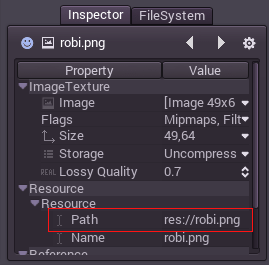Resources¶
Nodes and resources¶
So far, Nodes have been the most important datatype in Godot as most of the behaviors and features of the engine are implemented through them. There is another datatype that is equally important: Resource.
Where Nodes focus on behaviors, such as drawing a sprite, drawing a 3D model, physics, GUI controls, etc,
Resources are mere data containers. This means that they don’t do any action nor process any information. Resources just contain data.
Examples of resources are Texture, Script, Mesh, Animation, AudioStream, Font, Translation, etc.
When Godot saves or loads (from disk) a scene (.tscn or .scn), an image (png, jpg), a script (.gd) or pretty much anything, that file is considered a resource.
When a resource is loaded from disk, it is always loaded once. That means, if there is a copy of that resource already loaded in memory, trying to load the resource again will return the same copy again and again. This corresponds with the fact that resources are just data containers, so there is no need to have them duplicated.
Typically, every object in Godot (Node, Resource, or anything else) can export properties. Properties can be of many types (like a string, integer, Vector2, etc) and one of those types can be a resource. This means that both nodes and resources can contain resources as properties. To make it a little more visual:

External vs built-in¶
The resource properties can reference resources in two ways, external (on disk) or built-in.
To be more specific, here’s a Texture in a Sprite node:
Pressing the “>” button on the right side of the preview allows us to view and edit the resources properties. One of the properties (path) shows where it comes from. In this case, it comes from a png image.

When the resource comes from a file, it is considered an external resource. If the path property is erased (or it never had a path to begin with), it is considered a built-in resource.
For example, if the path `”res://robi.png”` is erased from the “path” property in the above example, and then the scene is saved, the resource will be saved inside the .tscn scene file, no longer referencing the external “robi.png”. However, even if saved as built-in, and even though the scene can be instanced multiple times, the resource will always be loaded only once. That means, different Robi robot scenes instanced at the same time will still share the same image.
Loading resources from code¶
Loading resources from code is easy. There are two ways to do it. The first is to use load(), like this:
func _ready():
var res = load("res://robi.png") # resource is loaded when line is executed
get_node("sprite").texture = res
public override void _Ready()
{
var texture = (Texture)GD.Load("res://robi.png"); // resource is loaded when line is executed
var sprite = (Sprite)GetNode("sprite");
sprite.Texture = texture;
}
The second way is more optimal, but only works with a string constant parameter because it loads the resource at compile-time.
func _ready():
var res = preload("res://robi.png") # resource is loaded at compile time
get_node("sprite").texture = res
// preload() is unavailable in C Sharp
Loading scenes¶
Scenes are also resources, but there is a catch. Scenes saved to disk are resources of type PackedScene. This means that the scene is packed inside a resource.
To obtain an instance of the scene, the method PackedScene.instance() must be used.
func _on_shoot():
var bullet = preload("res://bullet.tscn").instance()
add_child(bullet)
private PackedScene _bulletScene = (PackedScene)GD.Load("res://bullet.tscn");
public void OnShoot()
{
Node bullet = _bulletScene.Instance();
AddChild(bullet);
}
This method creates the nodes in the scene’s hierarchy, configures them (sets all the properties) and returns the root node of the scene, which can be added to any other node.
The approach has several advantages. As the PackedScene.instance() function is pretty fast, adding extra content to the scene can be done efficiently. New enemies, bullets, effects, etc can be added or removed quickly, without having to load them again from disk each time. It is important to remember that, as always, images, meshes, etc are all shared between the scene instances.
Freeing resources¶
Resource extends from Reference. As such, when a resource is no longer in use, it will automatically free itself. Since, in most cases, Resources are contained in Nodes, scripts or other resources, when a node is removed or freed, all the children resources are freed too.
Scripting¶
Like any object in Godot, not just nodes, resources can be scripted, too. However, there isn’t generally much of an advantage, as resources are just data containers.